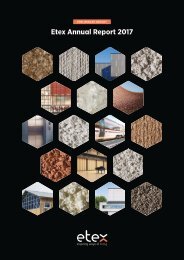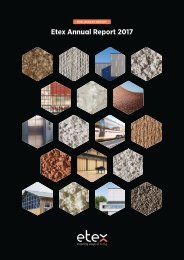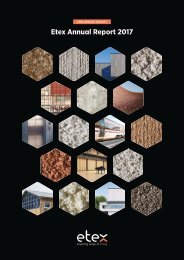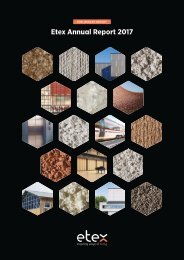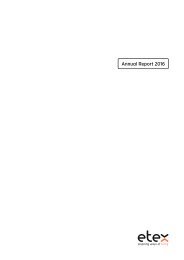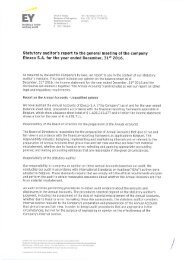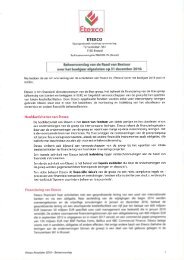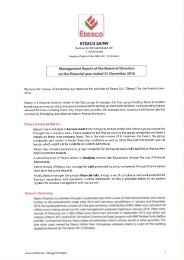Etex-AR2017-WEBSITE
Create successful ePaper yourself
Turn your PDF publications into a flip-book with our unique Google optimized e-Paper software.
6.1<br />
Financial report<br />
Consolidated financial statements<br />
<strong>Etex</strong> Annual Report 2017<br />
Financial report<br />
Consolidated financial statements<br />
Summary of audit procedures performed<br />
We assessed the Group‘s process for identifying and<br />
monitoring significant adverse developments arising<br />
from contingencies and where appropriate, legal,<br />
regulatory and political developments.<br />
For the claims, we made inquiries of group<br />
management and in-house legal counsel, reviewed<br />
the legal reports prepared by group management,<br />
obtained external lawyer confirmations, evaluated<br />
management’s assessment of the likely outcome and<br />
potential exposures and reviewed the appropriateness<br />
of the accruals for litigations.<br />
For health claims, we also assessed the compensations<br />
schemes including the used key assumptions and the<br />
impact of the local legislations.<br />
We performed group level analytical reviews<br />
procedures on provisions by comparing the movements<br />
of the provisions compared to prior year.<br />
We assessed the reasonableness of the assumptions<br />
used by management to estimate the provisions<br />
by comparing those assumptions to historical<br />
observations.<br />
We inspecting the meeting minutes of the board of<br />
directors and the audit committee, in which these<br />
claims and litigations are discussed.<br />
• Goodwill and specific asset impairment<br />
Description of the matter<br />
The Group’s assessment of impairment of Goodwill<br />
and certain assets disclosed as Property, Plant and<br />
Equipment is a judgmental process which requires<br />
estimates concerning the projected future cash flows<br />
associated with the Cash Generating Unit (“CGU”),<br />
the weighted average cost of capital (“WACC”) and<br />
the growth rate of revenue and costs to be applied in<br />
determining the value in use.<br />
For goodwill, the Group reviews the carrying amounts<br />
of its cash generating units annually of more frequently<br />
if impairment indicators are present. For Property,<br />
Plant and Equipment, the Group reviews the carrying<br />
amounts of its capital employed with the recoverable<br />
amount if impairment indicators are present (hereafter<br />
the “specific assets”).<br />
The impairment assessment involves a comparison<br />
of the estimated fair value of the CGU and specific<br />
assets to its carrying amount. Additional information<br />
is provided in note 7 and 8 of the Consolidated<br />
Financial Statements.<br />
Summary of audit procedures performed<br />
We have assessed the design and implementation<br />
of the Group‘s controls relating to Management‘s<br />
impairment review of goodwill and specific assets.<br />
We have tested the accuracy of the underlying model<br />
to assess whether the processes are applied to the<br />
correct input data.<br />
We challenged each of the key assumptions<br />
employed in the annual impairment test. These key<br />
assumptions include the WACC, the growth rates and<br />
projected cash flows. We have involved our internal<br />
valuation specialists to assess and benchmark those<br />
assumptions, to assess the used methodology and<br />
constituent inputs.<br />
We have made comparisons of the used cash flows<br />
to independent market forecasts of revenue and cost<br />
growth and we have assessed the Group's historic<br />
forecasting accuracy.<br />
We have assessed management’s sensitivity<br />
analyses and have assessed the appropriateness and<br />
completeness of the sensitivity disclosure.<br />
We have assessed the appropriateness and<br />
completeness of the disclosures in accordance with<br />
IAS 36 as included in note 8 and 9 of the Consolidated<br />
Financial Statements.<br />
• Risk in relation to the decentralized group structure<br />
Description of the audit matter<br />
<strong>Etex</strong> is a group with more than 150 legal entities. The<br />
geographical decentralized structure and the relatively<br />
small size of some of these entities to the group as<br />
a whole, increase the complexity of the company's<br />
control environment and as group auditor to obtain an<br />
appropriate level of understanding these entities.<br />
We have evaluated the Company’s entity level<br />
controls that address these risks, including centralized<br />
monitoring controls at level of the group and at the<br />
level of each division.<br />
Summary of audit procedures performed<br />
We have sent audit instructions to subsidiaries for the<br />
performance and reporting of local audit procedures. In<br />
determining the group audit scope, we have taken into<br />
account the relative weight of subsidiaries, the risk of<br />
subsidiaries and a rotation of insignificant subsidiaries.<br />
We have read and assessed the reporting documents<br />
by the local auditors and have discussed their findings<br />
with group management. We organized meetings and<br />
conference calls with components auditors in our group<br />
audit scope.<br />
During our audit, we have specifically focused on risks<br />
in relation to the decentralized structure by extending<br />
our involvement in local audit work performed by the<br />
component auditors.<br />
We have also requested component auditors to<br />
specifically address certain risks and attention<br />
areas defined at group level, by requiring all teams<br />
to complete specific risk-based questionnaires and<br />
detailed audit programs in order to ensure a consistent<br />
approach in areas that were deemed most relevant<br />
from a group audit perspective.<br />
Responsibilities of the Board of Directors for the<br />
preparation of the Consolidated Financial Statements<br />
The Board of Directors is responsible for the<br />
preparation of the Consolidated Financial Statements<br />
that give a true and fair view in accordance with<br />
the International Financial Reporting Standards as<br />
adopted by the European Union (“IFRS”) and with<br />
applicable legal and regulatory requirements in<br />
Belgium as well as internal controls relevant to the<br />
preparation of the Consolidated Financial Statements<br />
that are free from material misstatement, whether due<br />
to fraud or error.<br />
As part of the preparation of the Consolidated<br />
Financial Statements, the Board of Directors is<br />
responsible for assessing the Company s ability<br />
to continue as a going concern, and provide, if<br />
applicable, information on matters impacting going<br />
concern, The Board of Directors should prepare the<br />
financial statements using the going concern basis<br />
of accounting, unless the Board of Directors either<br />
intends to liquidate the Company or to cease business<br />
operations, or has no realistic alternative but to do so.<br />
Our responsibilities for the audit of the<br />
Consolidated Financial Statements<br />
Our objective is to obtain reasonable assurance<br />
whether the Consolidated Financial Statements<br />
are free from material misstatement, to express an<br />
opinion on these Consolidated Financial Statements<br />
based on our audit. Reasonable assurance is a high<br />
level of assurance, but not a guarantee that an audit<br />
conducted in accordance with the ISAs will always<br />
detect a material misstatement when it exists.<br />
Misstatements can arise from fraud or error and<br />
considered material if, individually or in the aggregate,<br />
they could reasonably be expected to influence the<br />
economic decisions of users taken on the basis of these<br />
Consolidated Financial Statements.<br />
As part of an audit, in accordance with ISAs, we<br />
exercise professional judgment and we maintain<br />
professional skepticism throughout the audit. We also<br />
perform the following tasks:<br />
• Identification and assessment of the risks of<br />
material misstatement of the Consolidated Financial<br />
Statements, whether due to fraud or error, the<br />
planning and execution of audit procedures to<br />
respond to these risks and obtain audit evidence<br />
which is sufficient and appropriate to provide a basis<br />
for our opinion. The risk of not detecting material<br />
misstatements is larger when these misstatements<br />
are due to fraud, since fraud may involve collusion,<br />
forgery, intentional omissions, misrepresentations,<br />
or the override of internal control;<br />
160 161



